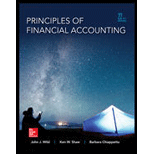
(a)
Calculate the selling
(a)
Explanation of Solution
1.
Selling price of bond:
Selling price of bond is the sum of present value of interest payments (annuity) and the principal amount (single sum). This is also known as issue price of bond.
Calculate the selling price of bonds:
| PV Factor (a) | Amount (b) | Present Value (a)×(b) | |
| Par value | 0.6139 | $90,000 | $55,251 |
| Interest (annuity) | 7.7217 | (2) $5,400 | $41,697 |
| Price of bonds | $96,948 | ||
| Bond premium | (7) $6,978 |
Table (1)
Therefore, the selling price of the bond is $96,948.
Note: Refer to Table B.1 from Appendix of textbook for Present value of $ 1 and refer to Table B.3 from Appendix of textbook for Present value of an annuity $ 1.
Working notes:
Calculate the semiannual face interest rate:
Calculate amount of interest payable.
Calculate the value of bond premium:
2.
Calculate the selling price of bonds:
| Cash Flow | PV Factor (a) | Amount (b) | Present Value (a)×(b) |
| Par value | 0.5584 | $90,000 | $50,256 |
| Interest (annuity) | 7.3601 | (5) $5,400 | $39,745 |
| Price of bonds | $90,001 |
Table (2)
Therefore, the selling price of the bond is $90,001.
Note: Refer to Table B.1 from Appendix of textbook for Present value of $ 1 and refer to Table B.3 from Appendix of textbook for Present value of an annuity $ 1.
Working notes:
Calculate the semiannual face interest rate:
Calculate amount of interest payable.
3.
Calculate the selling price of bonds:
| Cash Flow | PV Factor (a) | Amount (b) | Present Value (a)×(b) |
| Par value | 0.5083 | $90,000 | $45,747 |
| Interest (annuity) | 7.0236 | $5,400 | $37,927 |
| Price of bonds | $83,674 | ||
| Bond discount | (8) $6,326 |
Table (3)
Therefore, the selling price of the bond is $83,674.
Note: Refer to Table B.1 from Appendix of textbook for Present value of $ 1 and refer to Table B.3 from Appendix of textbook for Present value of an annuity $ 1.
Working notes:
Calculate the semiannual face interest rate:
Calculate amount of interest payable.
Calculate the value of bond premium:
(b)
Prepare
(b)
Explanation of Solution
1.
| Date | Account Titles and Explanation |
Debit ($) |
Credit ($) |
| 2015 | Cash | 96,948 | |
| January 1 | Premium on bonds payable (3) | 6,948 | |
| Bonds payable | 90,000 | ||
| (To record the sale of bonds on stated issue date.) |
Table (4)
- Cash is an asset and it is increased. Therefore cash is debited by $96,948.
- Premium on Bonds Payable is an adjunct liability account and it is increased. So, credit it by 6,948.
- Bonds payable is a liability and it is increased. Therefore credit bonds payable account by $90,000.
2.
| Date | Account Titles and Explanation |
Debit ($) |
Credit ($) |
| 2015 | Cash | 90,000 | |
| January 1 | Bonds payable | 90,000 | |
| (To record the sale of bonds on stated issue date.) |
Table (5)
- Cash is an asset and it is increased. Therefore cash is debited by $90,000.
- Bonds payable is a liability and it is increased. Therefore credit bonds payable account by $90,000.
3.
| Date | Account Titles and Explanation |
Debit ($) |
Credit ($) |
| 2015 | Cash | 83,674 | |
| January 1 | Discount on bonds payable (8) | 6,326 | |
| Bonds payable | 90,000 | ||
| (To record the sale of bonds on stated issue date.) |
Table (6)
- Cash is an asset and it is increased. Therefore cash is debited by $83,674.
- Discount on bonds payable is a contra liability and it is decreased. Therefore debit discount on bonds payable by $6,326.
- Bonds payable is a liability and it is increased. Therefore credit bonds payable account by $90,000.
Want to see more full solutions like this?
Chapter 14 Solutions
Principles of Financial Accounting.
- Total factory Overhead costs would bearrow_forwardCalculate the ending balance of accounts receivablearrow_forwardBrightstar Financial Services recorded several financial transactions during the period. The company received $38,500 in cash from credit customers and allowed $3,200 in sales discounts. Additionally, $2,100 in bad debts were written off. Given that the beginning balance of Accounts Receivable was $92,000, calculate the ending balance of Accounts Receivable. Helparrow_forward
- DuraWeave Textile Mill processes raw cotton into premium cleaned cotton. The raw cotton costs $6.50 per pound, but during the cleaning process, there is a 40% loss due to impurities and waste. After cleaning, the processing cost is $9.75 per pound of cleaned cotton. Additionally, a quality bonus of 12% is applied to the final cost of the cleaned cotton. Calculate the total cost of processing 250 pounds of raw cotton.arrow_forwardWhat distinguishes capacity utilization accounting from volume measures? A. Standard measures work fine B. Resource availability impacts supplement usage records C. Capacity remains constant D. Usage numbers tell everything MCQarrow_forwardI need help finding the accurate solution to this general accounting problem with valid methods.arrow_forward

 AccountingAccountingISBN:9781337272094Author:WARREN, Carl S., Reeve, James M., Duchac, Jonathan E.Publisher:Cengage Learning,
AccountingAccountingISBN:9781337272094Author:WARREN, Carl S., Reeve, James M., Duchac, Jonathan E.Publisher:Cengage Learning, Accounting Information SystemsAccountingISBN:9781337619202Author:Hall, James A.Publisher:Cengage Learning,
Accounting Information SystemsAccountingISBN:9781337619202Author:Hall, James A.Publisher:Cengage Learning, Horngren's Cost Accounting: A Managerial Emphasis...AccountingISBN:9780134475585Author:Srikant M. Datar, Madhav V. RajanPublisher:PEARSON
Horngren's Cost Accounting: A Managerial Emphasis...AccountingISBN:9780134475585Author:Srikant M. Datar, Madhav V. RajanPublisher:PEARSON Intermediate AccountingAccountingISBN:9781259722660Author:J. David Spiceland, Mark W. Nelson, Wayne M ThomasPublisher:McGraw-Hill Education
Intermediate AccountingAccountingISBN:9781259722660Author:J. David Spiceland, Mark W. Nelson, Wayne M ThomasPublisher:McGraw-Hill Education Financial and Managerial AccountingAccountingISBN:9781259726705Author:John J Wild, Ken W. Shaw, Barbara Chiappetta Fundamental Accounting PrinciplesPublisher:McGraw-Hill Education
Financial and Managerial AccountingAccountingISBN:9781259726705Author:John J Wild, Ken W. Shaw, Barbara Chiappetta Fundamental Accounting PrinciplesPublisher:McGraw-Hill Education





